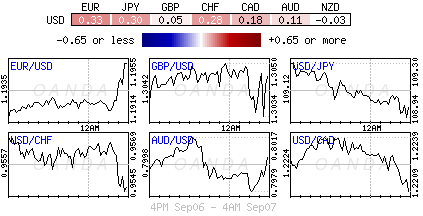Thursday September 7: Five things the markets are talking about
The best-laid plans sometimes fail to materialize. For instance, if the ECB had been hoping to exit QE undercover of the Fed’s observance to a predictable path of ‘normalisation’ has very much been complicated by stubbornly low U.S inflation and U.S political uncertainty.
The EUR has appreciated close to +14% since the start of this year outright, causing a few sleepless nights at the ECB because it has been pushing inflation lower, the opposite to what the Euro policy makers require.
What to expect from the ECB?
Consensus expect the ECB to delay announcing plans to reduce monetary stimulus or QE until October, following the ‘single’ unit’s recent rise above the psychological €1.20 handle – the banks pain threshold level. The ECB will have to revise inflation projections down, blaming the strong EUR, and to acknowledge further downside risks – which should cap the EUR for the short-term.
Note: Saying nothing would constitute an invitation to drive the EUR higher, which no doubt is not in the interest of the ECB.
The ‘smart’ money will be ‘short’ EUR’s or small core ‘long’ the single unit heading into this morning’s ECB press conference (08:30 am EDT) in particular, with many expecting Draghi to address the pace of EUR appreciation.
The markets objective will be to buy dips, which should be short lived as any decline will be used to position for a further move up in EUR/USD on a 6-12 month horizon (€1.25-27).
Elsewhere, the U.S dollar continues to struggle against its G-10 peers as tensions over North Korea outweigh positive sentiment arising from yesterday’s extension of the U.S debt limit. The market is also keeping an eye on Hurricane Ira (and crude prices), which is currently barrelling towards Florida.
1. Stocks get the green light
In Japan, the Nikkei share average rallied overnight, pulling away from its four-month intraday low after news of an agreement to raise the U.S debt limit yesterday helped restore investors’ risk appetites. The Nikkei ended +0.2% higher, while the broader Topix rallied +0.4%.
Down-under, Australia’s S&P/ASX 200 Index was little changed after Aussie retail sales data struggled last month (+0.0% vs. +0.2%e). In South Korea, the Kospi rallied +1.1%.
In Hong Kong, stocks reversed earlier gains to end lower overnight, pressured by losses in the mainland share market. The Hang Seng index fell -0.3%, while the China Enterprises Index lost -0.2%.
In China, equities fell, as profit taking in resource shares following their recent rally and weakness in the banking sector offset strong gains in real estate companies. The blue-chip CSI300 index fell -0.5%, while the Shanghai Composite Index lost -0.6%.
In Europe, regional bourses trade mixed with outperformance in the DAX, whilst weakness is observed on the FTSE 100 and the Swiss SMI. Markets are trading in a holding pattern ahead of this morning’s ECB rate decision and press conference.
U.S stocks are set to open in the red (-0.2%).
Indices: Stoxx600 flat at 373.8, FTSE flat at 7357, DAX +0.6% at 12283, CAC-40 +0.3% at 5115, IBEX-35 +0.1% at 10140, FTSE MIB -0.4% at 21739, SMI -0.2% at 8839, S&P 500 Futures -0.2%
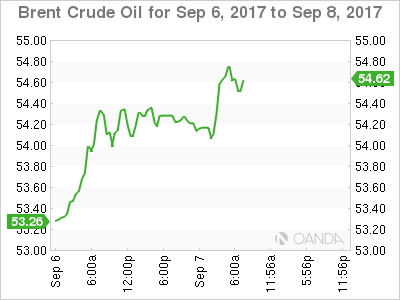
2. Oil dips on fears ‘Irma’ could hit crude shipments, gold steady
Oil prices have dipped a tad overnight over fears that Hurricane Irma could interrupt crude shipments in and out of the U.S, and as Libyan output begins to recover from disruptions.
Note: However, prices are receiving some support from rising demand in the U.S, where Gulf Coast refineries are restarting in the wake of Hurricane Harvey.
Brent crude futures have dipped -21c, or -0.4% to +$53.99 a barrel, while U.S West Texas Intermediate (WTI) crude futures are down -18c, or -0.4% at +$48.98 a barrel.
Also putting pressure on crude prices is oil output at Libya’s Sharara field, the country’s largest, resumed yesterday, which had been shut down for more than two-weeks.
Investors will take direction from todays EIA inventory report (11:00 am EDT).
Expectations that the Fed will raise rates gradually have been a boon for gold. Ongoing rising tensions between the U.S and North Korea have also boosted demand for the ‘yellow’ metal, contributing to a +15% gain this year.
Overnight, gold prices held steady, supported by a weaker dollar, as markets await the outcome of today’s ECB policy meet – spot gold is unchanged at +$1,333.90 per ounce, after easing -0.3% in yesterday’s session.
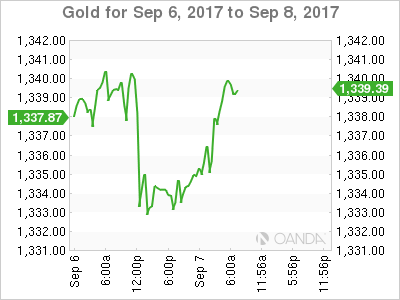
3. Unexpectedly ‘hawkish’ Draghi could trigger Bund sell-off
With the ECB expected to do whatever it takes to keep short end rates anchored has fixed income dealers believing that the eurozone bond yield cure will steepen even further. Current Eonia forwards imply no rate rises by the ECB until spring 2019.
Therefore, any ‘hawkish’ talk should push longer yields higher. If Draghi sounds more hawkish than expected, this would trigger a sell-off in German bunds, with 10-year yields rising back to the +0.40-0.45% area. 10-year Bund yields currently trade at +0.36%.
Elsewhere, U.S 10-year Treasuries declined -1 bps to +2.09%, while U.K Gilt yields back up +2 bps to +1.026%.
In Sweden, the Riksbank is sticking to its established policy script – this morning policy makers kept both policy and rate path unchanged. The statement reiterated that first rate hike will not be seen until mid-2018, but was prepared for more easing if necessary. Governor Ingves noted that the “domestic economy was developing better than expected, but its too early to make policy less expansionary.” The SEK ($7.9688) currency has strengthened faster than its July forecast.
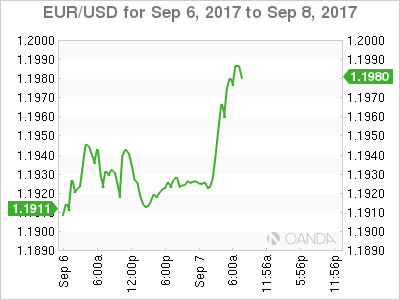
4. Dollar under pressure vs. G10
The EUR/USD (€1.1980) is trading at session highs ahead of the ECB rate decision. The ECB is expected to keep policy steady with particular focus on whether euro policy makers would provide any guidelines on its looming QE taper. No final decision on the next steps is expected until next month’s meeting.
Overall, the FX market is relatively quiet, but the USD remains on soft footing vs. its G10 counterparts. USD/JPY (¥108.88) is a tad lower as the Korea peninsula concerns remain on the front burner with another N. Korean missile launch possible ahead of Sept. 9.
GBP (£1.3071) has rallied to a four-week high ahead of the U.S open. Down-under overnight, the AUD (A$0.8015) briefly held some strength for most of the session before falling back after a tepid Aussie retail sales report last month.
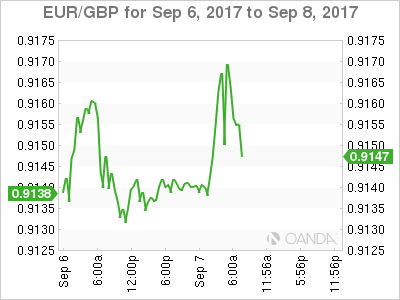
5. Eurozone economy stronger than estimated
Data this morning showed that the eurozone economy grew more quickly over the 12 months through June than previously estimated. Eurostat left its estimate of quarter-to-quarter growth for the three months to June unchanged at +0.6%. But, raised its estimate of growth in Q3, 2016 to +0.5% from +0.4%.
As a result, it now estimates that the economy was +2.3% larger in the three months to June than it was in the same period last year – the fastest rate of growth recorded in six-years.
Note: The Eurozone has outpaced the U.S in Q1 and accelerated further in the three months to June.
But data released by the European Union’s statistics agency showed the pickup began earlier than previously thought. it raised its estimate of growth in the third quarter of last year to 0.5% from 0.4%.
Note: The ECB is expected to raise their growth forecasts for this year and next later this morning.
